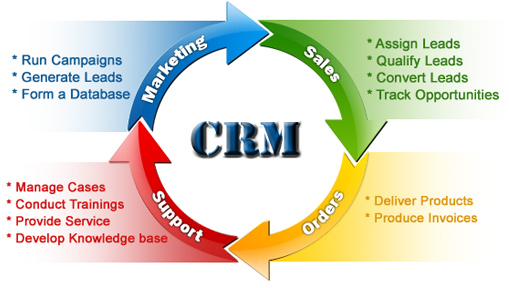Strategic CRM
Strategical Customer Relationship Management Systems

|
Strategic CRM is a core customer-centric business strategy that aims at winning and keeping profitable customers.
Strategic CRM is focused upon the development of a customer-centric business culture dedicated to winning and keeping customers by creating and delivering value better than competitors. The culture is reflected in leadership behaviors, the design of formal systems of the company, and the myths and stories that are created within the firm.
In a customer-centric culture you would expect resources to be allocated where they would best enhance customer value, reward systems to promote employee behaviors that enhance customer satisfaction and retention, and customer information to be collected, shared and applied across the business.
The heroes of customer-centric businesses deliver outstanding value or service to customers. Many businesses claim to be customer-centric, customer-led, customer-focused or customer-oriented but few are.
Indeed there can be very few companies of any size that do not claim that they are on a mission to satisfy customer requirements profitably. Customer-centricity competes with other business logics. Kotler identifies three other major business orientations: product, production and selling.
- Product-oriented
Product-oriented businesses believe that customers choose products with the best quality, performance, design or features. These are often highly innovative and entrepreneurial firms.
Many new business start-ups are product-oriented. In these firms it is common for the customer’s voice to be missing when important marketing, selling or service decisions are made. Little or no customer research is conducted.
Management makes assumptions about what customers want and/or provides visionary leadership for the market. Perhaps the most iconic example of product-orientation is AppleOpens in new window.
AppleOpens in new window has created huge demand for products that customers did not know they needed, for example the iPadOpens in new window. Leading fashion houses tend to be product-oriented and try to establish new fashion trends rather than respond to consumer research about what should be next year’s look. However, these are exceptional.
Product-oriented companies often over-specify or over-engineer for the requirements of the market, and therefore are too costly for many customers. The subset of relatively price-insensitive customers marketers dub “innovators”, who are likely to respond positively to company claims about product excellence, is a relatively small segment, perhaps 2.5 per cent of the potential market.
- Production-oriented
Production-oriented businesses focus on operational excellence. They seek to offer the customers the best value for money, time and/or effort. Consequently, they strive to keep operating costs low, and develop standardized offers and routes to market.
Complexity, customizationOpens in new window and innovation are very costly and unappealing to production-oriented businesses.
Production-oriented firms rarely are first to market with the best new offer. They focus their innovation on supply chain optimization and simplification. They tend to serve customers who want “good-enough”, low-priced products and services.
Production-oriented businesses choose not to believe that customers have unique needs or wants. It is possible to be highly profitable by being the lowest cost business player, for example WalmartOpens in new window.
There is a price and convenience segment in most markets but the majority of customers have other requirements.
Moreover, an excessive focus on operational efficiency might make you blind to disruptive changes just over the horizon; making cheap products that no one wants to buy is not a sustainable strategy.
- Sales-oriented
Sales-oriented businesses make the assumption that if they invest enough in advertising, selling, public relations (PR) and sales promotion, customers will be persuaded to buy.
Very often, a sales orientation follows a production orientation. The company produces low-cost products and then has to promote them heavily to shift inventory — a “make and sell” approach. The deal-maker and persuader is king in such firms.
In markets that are growing rapidly, such an approach can promote strong market share growth and attendant economies of scale. Many large technology firms have promoted an emphasis on selling. The risks of this orientation are twofold:
- winning large contracts is not the same thing as making money from them and
- focus on the immediate sale rarely allows enough slack resources to experiment and innovate to serve emerging needs and wants not yet articulated by customers.
- Customer or market-oriented
A customer or market-oriented company shares a set of beliefs about putting the customer first. It collects, disseminates and uses customer and competitive conditions. There is evidence that customer-centricity correlates strongly to business performance.
| Strategic CRM at Honda, Australia |
|---|
|
Many managers would argue that customer-centricity must be right for all companies. However, at different stages of market or economic development, other orientations may have stronger appeal.
See Also:
- Gamble, P., Stone, M. and Woodcock, N. (1999). Customer relationship marketing: up close and personal. London: Kogan Page; Jain, S. C. (2005). CRM shifts the paradigm. Journal of Strategic Marketing, 13 (December), 275 – 91.
- Evans, M., O’Malley, L. and Patterson, M. (2004). Exploring direct and customer relationship marketing. London: Thomson.
- Kotler, P. (2000), Marketing management: the millennium edition, Englewood Cliffs, NJ: Prentice-Hall International.
- Engle, R.L. and Barnes, M.L. (2000). Sales force automation usage, effectiveness, and cost-benefit in Germany, England and the United States. Journal of Business and Industrial Marketing, 15(4), 216 – 42.
- Buttle, F. (2004). Customer relationship management: concepts and tools. Oxford: Elsevier Butterworth-Heinemann.
- Payne, A. and Frow, P. (2013). Strategic customer management: integrating CRM and relationship marketing. Cambridge: Cambridge University Press, P. 211. See also Payne, A. (2005). Handbook of CRM: achieving excellence through customer management. Oxford: Elsevier Butterworth-Heinemann; Payne, A. and Frow, P. (2005). A strategic framework for customer relationship management. Journal of Marketing, 69 (October), 167 – 76.

